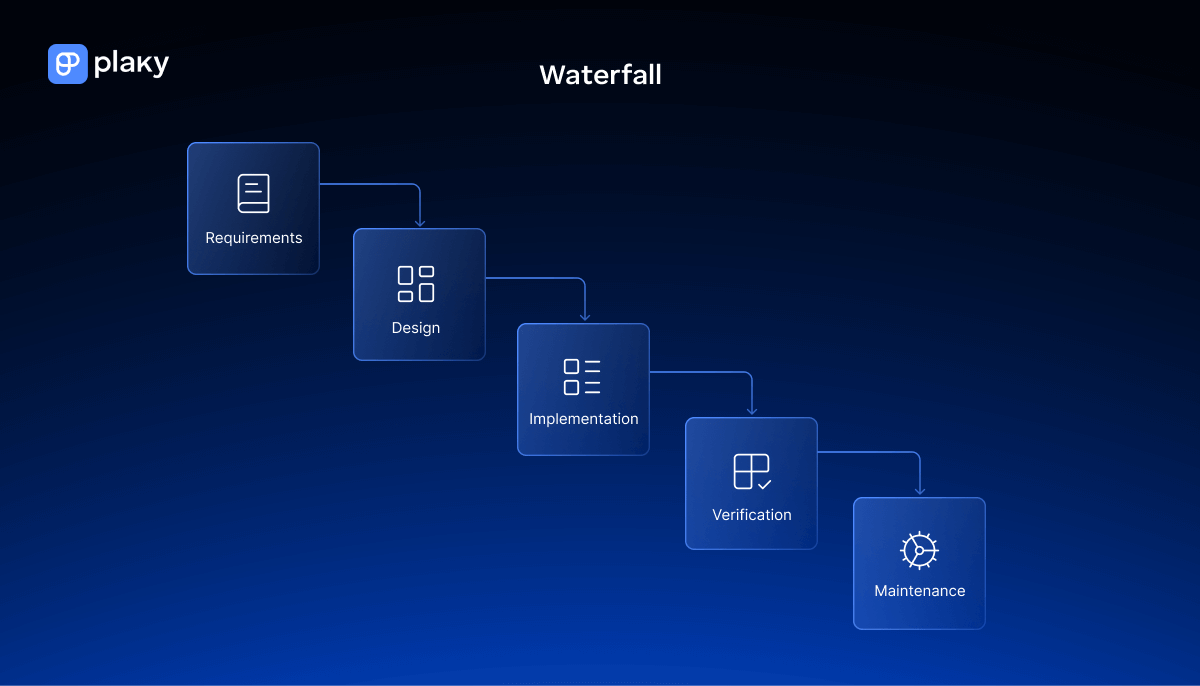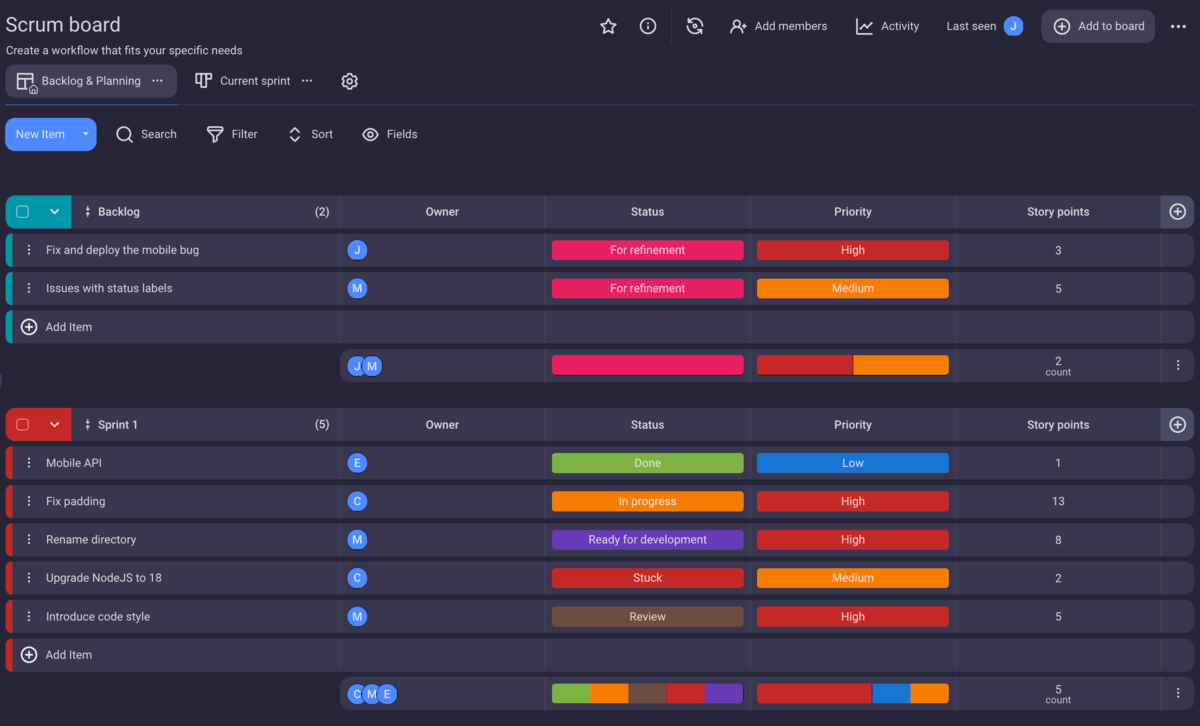In this guide, we’ll compare Waterfall, a traditional project management methodology, with one of the most popular Agile project management frameworks — Scrum.
We’ll address the key differences between these 2 approaches and clarify in which cases you should opt for each one of them.
So, keep reading.

- Waterfall is linear in nature, while Scrum is cyclic.
- Waterfall progresses through phases, Scrum progresses in Sprints.
- Scrum nurtures agility, Waterfall isn’t as flexible.
- Waterfall nurtures the autonomy of project roles, Scrum emphasizes cross-functionality.
- You should use Waterfall for less complex projects that are not likely to change, while Scrum is more suited for complex projects that change along the way.
- It’s possible to combine Scrum and Waterfall, which results in a hybrid project management approach sometimes referred to as Water-Scrum-Fall.
Scrum vs Waterfall: The main differences
The main differences between the Scrum framework and Waterfall methodologies are rooted in their distinct approaches to project management, particularly in terms of project lifecycle, adaptability to change, and emphasis on cross-team collaboration.
To be more specific, the 4 key differences between Scrum and Waterfall are the following:
- Waterfall is linear, Scrum is cyclic,
- Waterfall progresses in phases, Scrum has Sprints, each akin to a mini project whose aim is to produce working software,
- There’s not much room for change in Waterfall, Scrum embraces change, and
- Waterfall nurtures autonomy, Scrum emphasizes the cross-functionality of teams.
Now, let’s analyze these differences in more detail.
Difference #1: Waterfall is linear, Scrum is cyclic
Waterfall maps out projects into separate, sequential phases, and tasks are performed in a certain order.
Scrum, on the other hand, is a cyclic approach that is flexible and continually evolving. The Scrum Team involves the Product Owner, Developers, and the Scrum Master. The team meets for Daily Stand-ups to review their work, and the Scrum Master facilitates these meetings to help with any obstacles.

Difference #2: Waterfall progresses in phases, Scrum has Sprints
In Waterfall, you cannot start a phase until the previous one ends. The 5 Waterfall project phases include:
- Requirements,
- Design,
- Implementation,
- Verification, and
- Maintenance.
In Scrum, there are short periods of time called Sprints when team members work toward creating valuable results. Each Sprint may be seen as a short project within a greater project.
The Sprint contains all other Scrum Events, including:
- Sprint Planning,
- Daily Scrum,
- Sprint Review, and
- Sprint Retrospective.

💡 Plaky Pro Tip
Manage your Sprints better with the help of the right Scrum tool. Explore pros and cons of the top 12 Scrum tools in the following article:
Difference #3: There’s not much room for change in Waterfall, Scrum is agile
Unlike Scrum which nurtures agility, Waterfall isn’t as flexible.
In Waterfall, as its name suggests, the work cascades like a waterfall — each project phase follows the completion of the previous one.
Due to this sequential nature, there isn’t much room for change in Waterfall.
Scrum, on the other hand, is specifically designed for projects that often need to change along the way. This is why the development team performs work in short cycles, which is reviewed after each one.
Difference #4: Waterfall nurtures autonomy, Scrum emphasizes cross-functionality
Another difference between Scrum and Waterfall lies in their focus on the cross-functionality of the teams.
In Waterfall, each team member usually has their own responsibilities and works on their individual task autonomously.
Scrum, on the other hand, strongly promotes teamwork and the formation of cross-functional teams that work together toward a common goal.
💡 Plaky Pro Tip
Respect for other teammates and their points of view is one of the essential Scrum Values. Read more about these values here:
When to use Waterfall
You should use the Waterfall model if you’re running a less complex project that’s less likely to change along the way.
Also, you’ll probably benefit more from the Waterfall approach if your project has some of the following characteristics:
- You have well-defined project requirements and processes,
- Team member roles are clearly defined,
- There are single delivery timeframes,
- You have a detailed project plan that’s not likely to change,
- You have a client who’s not heavily involved in the project,
- You have a fixed-price project, or
- It is a repeatable project.
Our contributor, Serg Dmitriev, a Certified Scrum Trainer, Business Therapist, and the Founder and CEO of Unusual Concepts Agile, advises when it’s best to opt for Waterfall:

“Waterfall is a linear and structured approach, ideal for projects with clear, unchanging goals in a predictable environment. Usually, you will have a fixed scope and end up with unpredictable finish time and an overspent budget.”
When to use Scrum
You should use Scrum for more complex projects, such as agile software development projects, where changes occur often throughout the project lifecycle.
Also, you’ll probably benefit more from the Scrum approach if your project has some of the following characteristics:
- There’s more complexity,
- It’s a longer-term project,
- It requires more teamwork and accountability,
- There’s more focus on business value,
- You need opportunities to observe and test throughout the project,
- You need to be able to make adjustments along the way,
- The project evolves along the way.
Serg Dmitriev explains in what cases it’s best to opt for Scrum:

“Scrum on the contrary [to Waterfall] is ideal for a highly complex environment with a lot of unknowns, offering adaptability and frequent reassessment. Scrum will allow you to have a fixed budget and fixed delivery date leaving the scope unfixed.”
Can you combine Scrum and Waterfall?
According to the research on the use of Agile and traditional development practices, the application of Scrum within the Waterfall project management framework exists within certain companies, and it is referred to as Water-Scrum-Fall.
Some companies, particularly large ones, use a traditional process for outlining basic management procedures but implement Agile methods and practices to run specific projects.
📖 Now that you know what Scrum and Waterfall are, dive further into the topic of project management — check out our Project Management Glossary of Terms and get acquainted with project management terminology.
Use the Plaky project management tool for tracking your project lifecycle
Regardless of the approach you opt for, Waterfall or Scrum, using dedicated project management software can make overall management a lot easier.
For instance, the Plaky project management tool allows you to break down your projects into smaller chunks or work items.

Plaky allows you to organize your work items into categories of your choice (e.g. by phases or Sprints) and further specify them with information such as:
- Due dates,
- Assignees or owners, and
- Various color-coded labels such as status or priority labels.
Having all important project information available in real time wherever you are will make your project more transparent and team members coordinated better.
Start managing your projects more transparently and immediately boost collaboration within your team. Sign up for Plaky today!
How we reviewed this post: Our writers & editors monitor the posts and update them when new information becomes available, to keep them fresh and relevant.